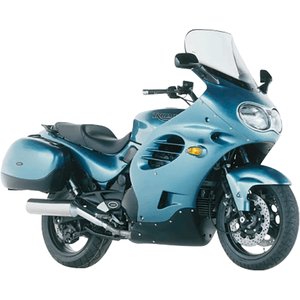Triumph Trophy 1200 (1992–1996): A Timeless Sport-Touring Contender Revisited
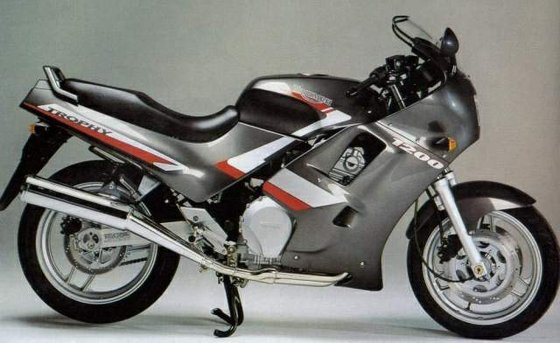
Introduction
When Triumph reemerged in 1991 with the Trophy 1200, it wasn’t just a motorcycle—it was a statement. John Bloor’s vision of reviving the British marque culminated in a machine that blended Japanese engineering precision with European character. The Trophy 1200, part of Triumph’s modular family, became an instant benchmark for sport-touring excellence. Even today, straddling this 1990s legend feels like unlocking a time capsule of innovation, one that still holds its own against modern expectations. This review explores what made the Trophy 1200 a revelation and why it remains a compelling choice for riders seeking a visceral, analog touring experience.
Design & Styling: Form Meets Functionality
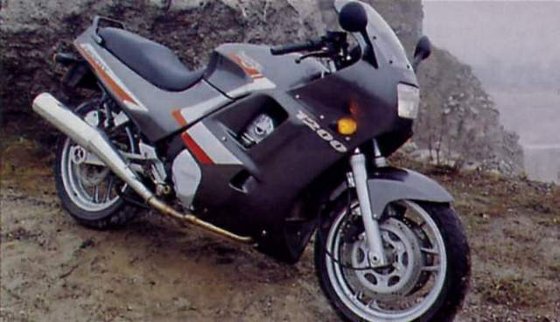
The Trophy 1200’s design ethos prioritized substance over flash. Its steel trellis frame, shared across Triumph’s modular range, gave it a purposeful, industrial aesthetic. The bodywork—a full fairing with integrated twin headlights—wasn’t groundbreaking, but it was effective. Wind protection was exceptional for its era, with a broad screen deflecting airflow over the rider’s torso.
The cockpit featured a straightforward analog gauge cluster (speedo, tach, temp) flanked by basic warning lights. Later models added a digital clock, a small but welcome touch. Fit and finish were surprisingly refined, with thick paint and tight panel gaps that put some Japanese rivals to shame. While the Trophy’s styling leaned conservative, its timelessness has aged better than the angular, plasticky designs of its competitors.
Engine & Performance: Torque Is the New Horsepower

At the Trophy’s heart lay its 1,180cc liquid-cooled inline-four—a masterpiece of accessible power. With 114 hp @ 9,100 rpm and a colossal 94.1 Nm (69.4 lb-ft) of torque, this engine wasn’t just strong; it was relentless. Throttle response from the 36mm CV carburetors was crisp, delivering a linear surge from as low as 2,000 rpm.
Twist the grip at highway speeds, and the Trophy lunges forward with a muted howl, its twin balancer shafts keeping vibrations eerily absent. The real magic lies in midrange grunt: roll-on acceleration from 120 km/h (75 mph) feels urgent even by modern standards. Triumph claimed a top speed of 242.7 km/h (150.8 mph), but it’s the 0–160 km/h (0–100 mph) sprint in under 7 seconds that impresses most.
Fuel economy? Expect 7.2 L/100 km (32.5 US mpg) during spirited riding—reasonable for a 228 kg (503 lb) tourer. The 25L (6.6 US gal) tank ensures 300+ km (186+ mi) between stops.
Handling & Comfort: Confidence at Any Pace
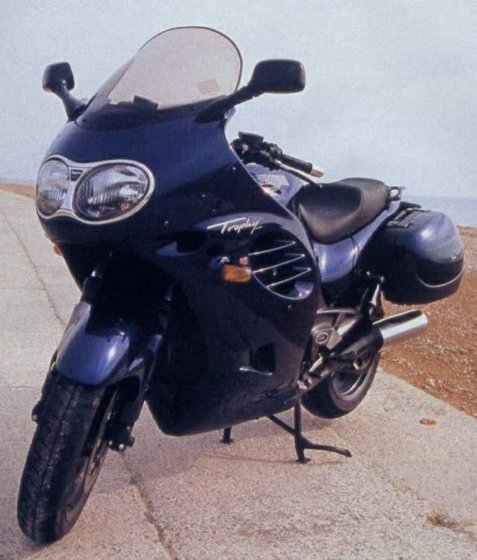
Weighing 228–235 kg (503–518 lb) dry, the Trophy isn’t light, but its chassis masks heft brilliantly. The 43mm Kayaba forks and monoshock (adjustable for preload and damping) strike a balance between plushness and control. Over battered backroads, the suspension absorbs imperfections without wallowing, while aggressive cornering reveals surprising poise.
Steering is neutral, aided by a conservative 27° rake and 105mm (4.1") trail. Push hard into a bend, and the Dunlop Sport radials (120/70-17 front, 170-180/55-17 rear) communicate grip levels clearly. Ground clearance is ample for a tourer, though footpegs will scrape before anything critical touches down.
Ergonomics are pure sport-touring: an upright riding position with a 790mm (31.1") seat that’s narrow yet supportive. The handlebars sit slightly forward, encouraging a relaxed lean. Pillion accommodations are generous, and the optional hard luggage system (color-matched to the fairing) remains a practicality benchmark.
Competition: How the Trophy Stacked Up
The Trophy 1200 entered a golden age of sport-touring, facing icons like:
- Honda ST1100: Honda’s V4 offered smoother power and linked brakes but lacked the Triumph’s torque-heavy thrills.
- Kawasaki ZZ-R1100: A speed-focused missile with 142 hp, yet its riding position and fuel range lagged behind.
- Yamaha FJ1200: Yamaha’s air-cooled brute matched the Trophy’s torque but couldn’t rival its refinement or handling.
- BMW R1100RS: The BMW’s boxer twin provided character and shaft drive, albeit with less urgency above 5,000 rpm.
Where the Trophy excelled was balance. It matched Japanese reliability while delivering a tactile, engaging ride that Europeans adored. Even today, used Trophy 1200s offer a rawer, more involving alternative to antiseptic modern tourers.
Maintenance: Keeping the Legend Roadworthy

Owning a Trophy 1200 today requires vigilance but rewards with simplicity. Key considerations:
- Carburetor Tuning: The Keihin CV carbs demand synchronization every 8,000–10,000 km (5,000–6,200 mi). A clogged pilot jet can disrupt low-end response.
- Cooling System: Flush coolant every 2 years and inspect hoses for brittleness. Early models occasionally suffered thermostat hiccups.
- Chain Care: The O-ring chain lasts 20,000–25,000 km (12,400–15,500 mi) with regular lubrication. Upgrade to a premium X-ring chain for longevity.
- Valve Adjustments: Check clearance every 12,000 km (7,500 mi). Intake: 0.10–0.15mm (0.004–0.006"), exhaust: 0.15–0.20mm (0.006–0.008").
- Brake Upgrades: Stock Nissin calipers lack bite. Swap pads for sintered compounds and consider braided stainless lines.
At MOTOPARTS.store, we recommend:
- NGK DPR8EA-9 Spark Plugs: Optimal for the Trophy’s ignition curve.
- 10W-40 Synthetic Blend Oil: Protects the high-revving four while reducing clutch drag.
- Aftermarket Windshields: A taller screen eliminates buffeting on long hauls.
Conclusion: Why the Trophy Still Matters
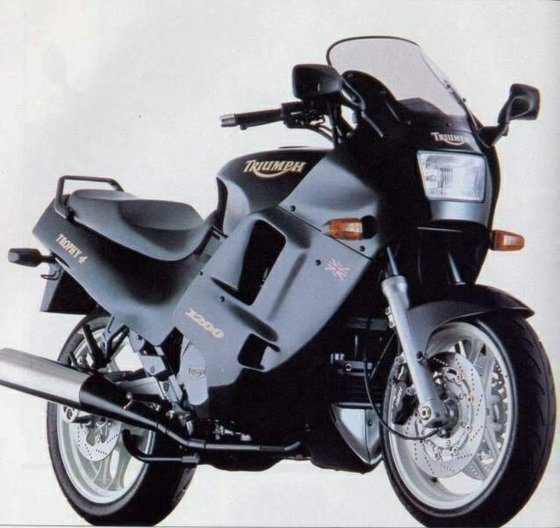
The Triumph Trophy 1200 wasn’t just a comeback story—it redefined what a British motorcycle could be. Its blend of turbine-like power, unflappable handling, and touring comfort remains unmatched in the analog era. For riders seeking a classic that’s neither finicky nor outdated, the Trophy delivers soul-stirring performance without the complexity of modern electronics.
Whether carving Alpine passes or devouring interstate miles, this Hinckley legend proves that some motorcycles aren’t just built—they’re engineered to endure.
Explore our curated selection of Triumph Trophy 1200 parts and accessories at MOTOPARTS.store—where heritage meets reliability.


Specifications sheet
| Engine | |
|---|---|
| Stroke: | Four-stroke |
| Ignition: | Digital - Inductive type |
| Max power: | 114 kW | 153.0 hp |
| Max torque: | 104 Nm |
| Fuel system: | 4 x 36 mm Flat side CV carburetors |
| Lubrication: | Wet sump |
| Max power @: | 9100 rpm |
| Displacement: | 1180 ccm |
| Max torque @: | 5000 rpm |
| Configuration: | Inline |
| Cooling system: | Liquid cooled |
| Compression ratio: | 10.6:1 |
| Number of cylinders: | 4 |
| Dimensions | |
|---|---|
| Wheelbase: | 1490 mm (58.7 in) |
| Dry weight: | 235 |
| Wet weight: | 267 |
| Seat height: | 790 mm (31.1 in) |
| Overall width: | 790 mm (31.1 in) |
| Overall height: | 1430 mm (56.3 in) |
| Overall length: | 2152 mm (84.7 in) |
| Ground clearance: | 165 mm (6.5 in) |
| Fuel tank capacity: | 25 L (6.6 US gal) |
| Drivetrain | |
|---|---|
| Final drive: | chain |
| Chain length: | 112 |
| Transmission: | 6-speed |
| Rear sprocket: | 45 |
| Front sprocket: | 18 |
| Maintenance | |
|---|---|
| Rear tire: | 180/55 z-17 |
| Engine oil: | 10W40 |
| Front tire: | 120/70 z-17 |
| Brake fluid: | DOT 4 |
| Spark plugs: | NGK DPR8EA-9 or NGK DPR8EIX-9 |
| Spark plug gap: | 0.9 |
| Coolant capacity: | 3.0 |
| Forks oil capacity: | 1.2 |
| Engine oil capacity: | 3.5 |
| Engine oil change interval: | Every 5000 km or 2 years |
| Valve clearance (intake, cold): | 0.10–0.15 mm |
| Valve clearance check interval: | 24,000 km (15,000 mi) |
| Valve clearance (exhaust, cold): | 0.15–0.20 mm |
| Recommended tire pressure (rear): | 2.9 bar (42 psi) |
| Recommended tire pressure (front): | 2.5 bar (36 psi) |
| Performance | |
|---|---|
| Top speed: | 242.7 km/h (150.8 mph) |
| Standing ¼ mile: | 10.9 sec @ 200.8 km/h (124.8 mph) |
| Fuel consumption (average): | 7.2 L/100 km (32.5 US mpg) |
| Chassis and Suspension | |
|---|---|
| Rake: | 27° |
| Frame: | Steel trellis frame |
| Trail: | 105 mm (4.1 in) |
| Rear brakes: | Single 255 mm disc, 2-piston caliper |
| Front brakes: | 2 x 310 mm discs, 4-piston calipers |
| Rear suspension: | Monoshock, adjustable preload and rebound damping |
| Front suspension: | 43 mm telescopic fork, adjustable for compression, rebound damping, and preload |
| Rear wheel travel: | 163 mm (6.4 in) |
| Front wheel travel: | 160 mm (6.3 in) |



